基于OFDM的大气激光通信湍流抑制关键技术研究
郭 倩,宋 鹏,张周强,周阿维,屈萍鸽
基于OFDM的大气激光通信湍流抑制关键技术研究
郭 倩*,宋 鹏,张周强,周阿维,屈萍鸽
西安工程大学机电工程学院,陕西 西安 710048
文章在分析无线激光通信(FSO)存在两种主要的大气信道问题的基础上,针对激光大气信道问题尤其是在复杂湍流环境下的频率选择性衰落问题和多径效应问题,提出了基于正交频分复用(OFDM)的湍流效应抑制方法,构建了FSO-OFDM系统,研究了该系统的基带模型以及信号的多载波调制与解调方法。分析了无线激光通信中存在复杂湍流环境下的大气信道问题,讨论了大气湍流影响下的平面波激光通信系统模型,建立了大气湍流影响下对数正态湍流通道的高斯光束空间光通信系统模型,推导了光波强度的概率密度函数,研究了利用信噪比概率密度函数分析各种大气湍流效应对系统性能影响的方法;设计了无线光通信系统的OFDM多载波调制方案,构建了FSO-OFDM系统基带模式模型,并基于该模型研究了其信号的调制与解调原理。最后,采用MATLAB编程实现FSO-OFDM系统,对多径干扰下的FSO通信系统进行仿真实验,进行了不同保护间隔下的误码率特性实验,验证了FSO-OFDM系统具有很强的抗多径干扰和频谱选择性衰落能力以及良好的BER性能,可有效解决码间干扰大、链路不可靠的问题,具有非常广泛的应用前景和使用价值。
无线光通信;湍流效应;正交频分复用;多径衰落;误码率
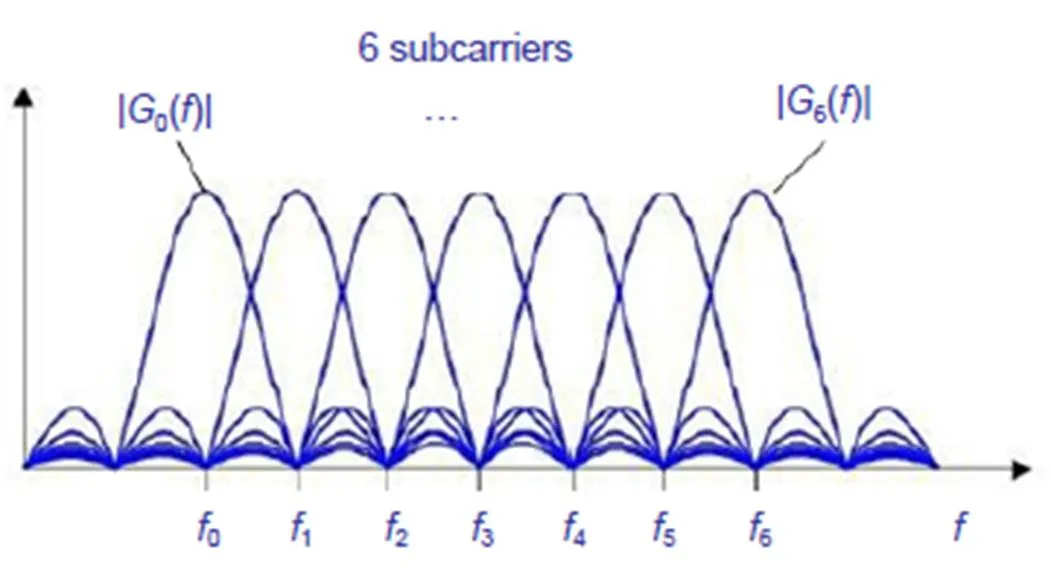
1 引 言
无线光通信属于大气波导通信,是近三十年来快速发展的一种通信速率高、组网灵活、波束窄、保密性好、易于维护的新型通信手段,已成为目前国际上的一大研究热点[1]。但是大气信道湍流效应,会导致无线激光通信(free space optics,FSO)出现码间干扰大、链路不可靠等问题,严重影响无线光通信系统的性能与技术应用。为此,国内外学者开展了许多理论与实验研究。1981年,Lukin等人对大气折射率的低频波动对有限空间光束相位波动的影响进行了研究,给出了大量关于光波相位起伏统计特性的实验数据[2];2008年以来,西安理工大学的柯熙政教授等人,研究了大气湍流效应及无线光通信技术中的大功率、高码率发射技术、PPM调制技术等[3],解决了很多关键问题,并研究制成了空间相干光通信系统、无线激光综合业务通信机等实验系统;2011年,哈尔滨工业大学的韩立强开展了大气湍流效应下空间光通信的性能及补偿方法研究[4],提出采用自适应光学技术减小大气湍流效应对空间光通信的影响;2012年,西安电子科技大学的易湘研究了基于分集接收技术的相干大气激光通信系统[5];2015年,廖天河等人建立了不同波束激光在大气湍流传输的数学模型,发现矩形光束可大大减弱湍流效应[6];2018年,Švihlík等开展了光强波动条件下光波畸变自适应相位校正研究,首次从实验上解释了强度波动条件下,湍流大气中光波传播的自适应相位校正效率降低的原因[7];2019年,Krbcová等研究了不同曝光时间和CCD相机噪声水平下的最佳参数设置,所得结果可推广应用于湍流噪声的抑制。目前围绕空间光及大气信道的研究虽已取得一定进展,但湍流效应仍是空间光通信应用的瓶颈[7]。基于此,文章将重点讨论大气激光通信湍流效应对空间光通信信号的影响机理及抑制方法。
正交频分复用(Orthogonal frequency division multiplexing,OFDM)是一种优秀的多载波通信技术,适用于基于FDM技术的高速数据传输。它可以有效地减少由多径效应引起的符号之间的串扰,并且具有高频谱利用率和对大气湍流的强抵抗力。这为突破光通信的瓶颈提供了技术方法,具有非常广泛的应用前景和使用价值。
为了解决无线光通信系统在复杂湍流环境下的频率选择性衰落问题和多径效应问题,改善激光信号大气信道传输问题,文章在深入探讨大气湍流效应形成原因及影响机理基础上,建立了大气湍流影响下对数正态湍流通道的高斯光束空间光通信系统模型,推导出了光波强度的概率密度函数,并利用该信噪比概率密度函数分析各种大气湍流效应对系统性能的影响;研究了OFDM调制原理,基于大气通道的特点,合理构建出了FSO-OFDM系统模型;最后,对多径干扰下的FSO通信系统进行仿真实验,在相同带宽条件下分别对单载波无线光通信系统和FSO-OFDM通信系统的平均误码率性能进行了仿真。经实验验证,所设计的无线光正交频分复用系统,与传统的单载波系统相比,改善了激光信号大气信道传输问题,提高了信息传输速率。
2 激光大气传输理论分析
2.1 湍流效应
湍流效应会导致大气折射率随机起伏,使接收端光信号发生闪烁、漂移和光斑失真等现象,对无线光通信系统的信噪比、误码率等性能指标产生很大的影响。为了最大化无线光通信系统的优点,首先需要探索无线光通信系统的传输环境,并了解大气信道对无线光通信系统的机制和影响。
大气环境与大气激光通信系统性能之间的关系如图1所示。
通常用雷诺数(Re)来描述湍流效应的运动特性。
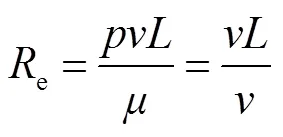
式中:为流动速度,为流体密度,是流体系数。
2.2 湍流效应的级串特性
湍流是一种高度复杂的三维非稳态、带旋转的不规则流动[8]。从图2可以看出湍流由各种尺度的涡流组成。其中,大的涡旋不稳定会持续分裂为小的涡旋,直至雷诺数小到某一数值时,也就是说,当大涡旋继续分裂时,它不会停止,这是湍流的弦性。图3是Richardson提出的湍流串特征图。
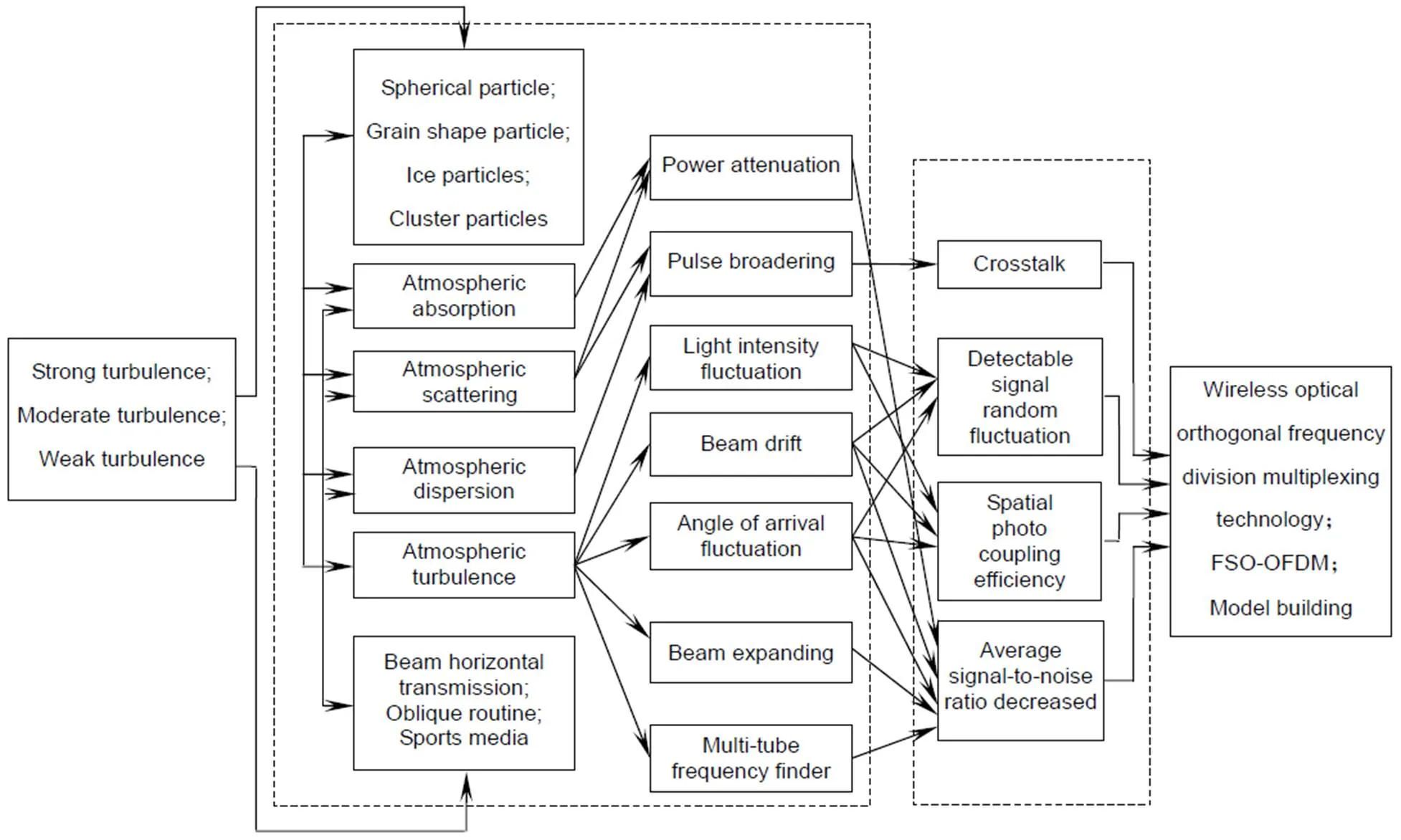
图1 大气环境与无线光学系统性能之间的关系

图2 大气信道湍流涡旋
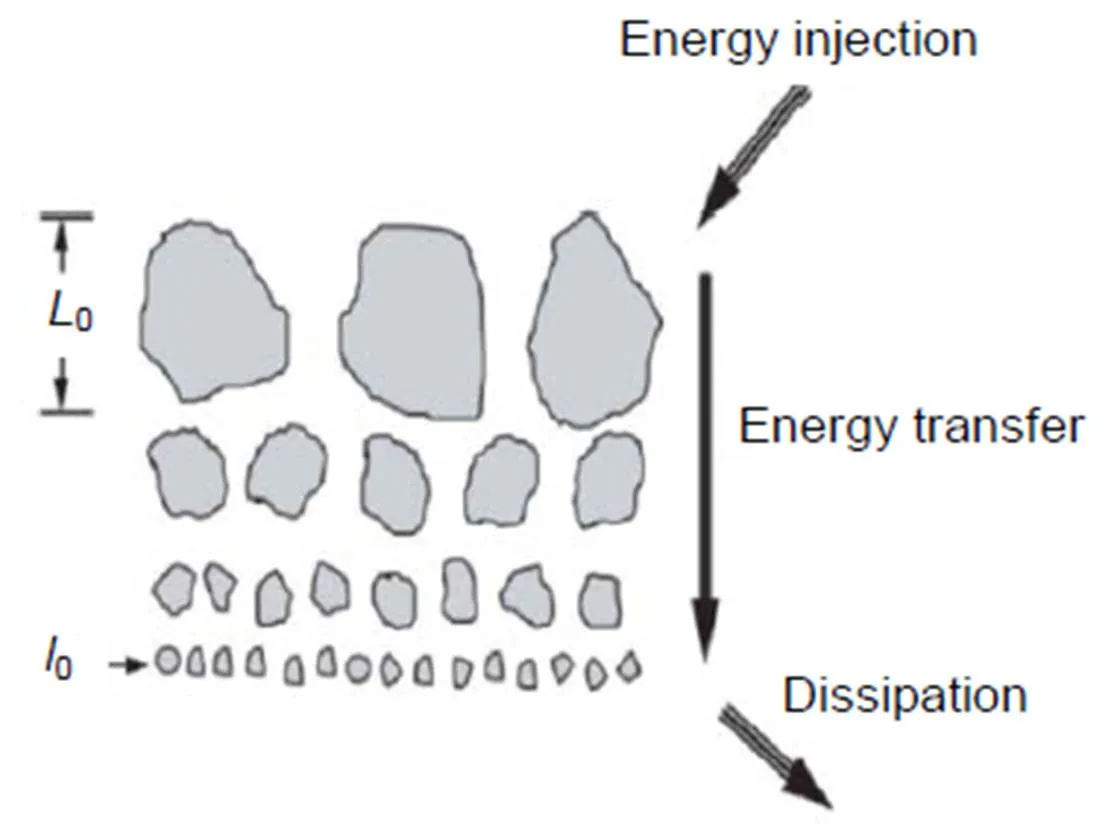
图3 Richardson湍流级串图
3 激光大气传输数值计算
在给出Kolmogorov谱模型的基础上,研究了平面波模型,建立了Log-normal湍流信道下的高斯光束空间光通信系统模型,推导得出系统光波强度的概率密度函数,可利用该光波强度的概率密度函数分析各种大气湍流效应对系统性能的影响。
3.1 Kolmogorov折射率起伏功率谱
大气湍流折射率波动功率谱主要基于Kolmogorov湍流理论。
大气湍流导致大气光学折射率随机波动。大气折射率是由空气的温度和压强的变化引起的,因而它是压强和温度的函数[9],其表示式为

其中:为波长,为压力,为热力学温度。Kolmogorov理论认为:对于局部均匀和各向同性的湍流,折射率的变化可以通过折射率结构函数来表征,该折射率结构函数与标量距离的功率成比例[10]。

在Kolmogorov提出的大气折射率结构函数的“2/3次方定律”的基础上,可以得到描述大气湍流造成的折射率起伏的功率谱[11]。Kolmogorov谱可写为

式中:=2p/为空间波数,为湍流涡旋的尺度。
3.2 激光大气传输平面波模型
基于先前得到的Kolmogorov折射率功率谱模型,在大气湍流中传播的平面波的对数幅度波动方差如下。
水平均匀路径:

斜程传输路径:

式中:为天顶角(<60°),sec为对斜程路径的修正因子。
基于Kolmogorov折射率功率谱模型,在大气湍流中传播的球面波的对数幅度波动方差如下。
水平均匀路径:

斜程传输路径:

3.3 光波强度的概率密度分布


对于平面波水平均匀路径传输,对数光强起伏方差可写为



因此

为了得到光波强度的概率密度函数,采用变量替换:
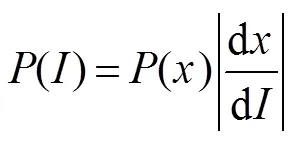
又基于对数振幅的概率密度函数可表示为


将式(14)代入式(13)中,得到Log-normal概率密度分布函数为

4 激光大气传输模型建立
4.1 OFDM
正交频分复用(OFDM)的概念于20世纪50~60年代提出,属多载波调制。正交频分复用(OFDM)技术可用于通过串行到并行转换来转换高速数据流[12],从而相对增加每个子载波上的数据符号的持续时间,减少由信道的时间弥散带来ISI(intersymbol interference)。其调制原理图如图4所示。
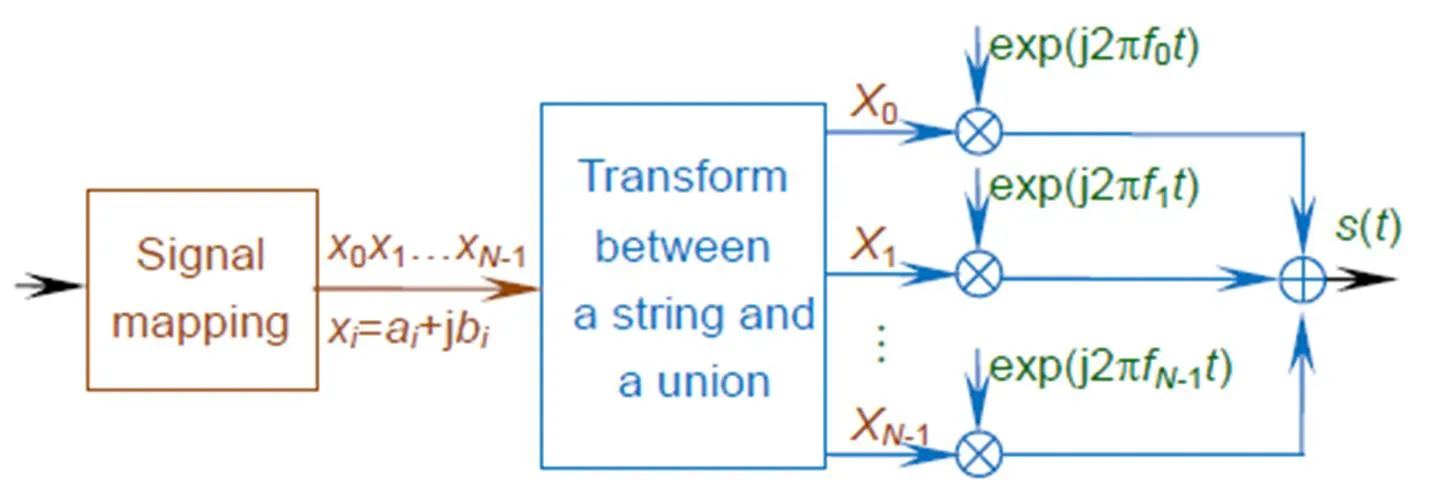
图4 OFDM调制原理
与其它调制方式相比,正交频分复用技术OFDM具有频带利用率高、抗噪音干扰能力强、抗窄带干扰能力强、抗多径衰落能力强等特点。它的本质是将信道分成若干正交子信道,将高速数据信号转换成并行的低速子数据流,进行并行传输。其并行传输原理图如图5所示。
4.2 系统建模
文章采用频谱效率高、抗大气效应能力强的OFDM新型传输技术,并充分考虑FSO通信系统的特点及OFDM技术的调制原理,将二者进行技术融合,构建出了FSO-OFDM系统的基带模式结构图,主要包括OFDM调制模块、电光转换模块、大气信道模块、光电转换模块以及OFDM解调模块。如图6所示。
4.3 系统光信号调制与解调
基于所搭建的无线光通信正交频分复用FSO- OFDM系统基带模型,实现对大气激光通信系统光信号的调制与解调。首先,当二进制信号源的信号发出后,由数据编码调制输出给串并转换模块,进行串并转换,再进行IFFT交换,然后经过数模转换及滤波后,进行电光转换,即成为了OFDM调制后的信号();该信号经过大气信道后,发送至FSO-OFDM系统的接收模块,对其进行光电转换,低通滤波,后经模/数转换,恢复成子载波的正交性,再经FFT和串/并转换后,恢复成OFDM调制前的信号,最后经解调解码,还原出原始输入信号。
FSO-OFDM系统的信号调制与解调过程如图7所示。
可以看出,由于该系统采用了正交频分复用多载波调制技术,故可实现多个子频带信号的并行传输,大大提高了频带利用率;且由于各子频带之间为正交关系,可使用FFT/IFFT算法轻松实现信号调制与解调,大大减少了运算量,从而降低系统对器件的要求。

图5 OFDM多载波并行传输原理图
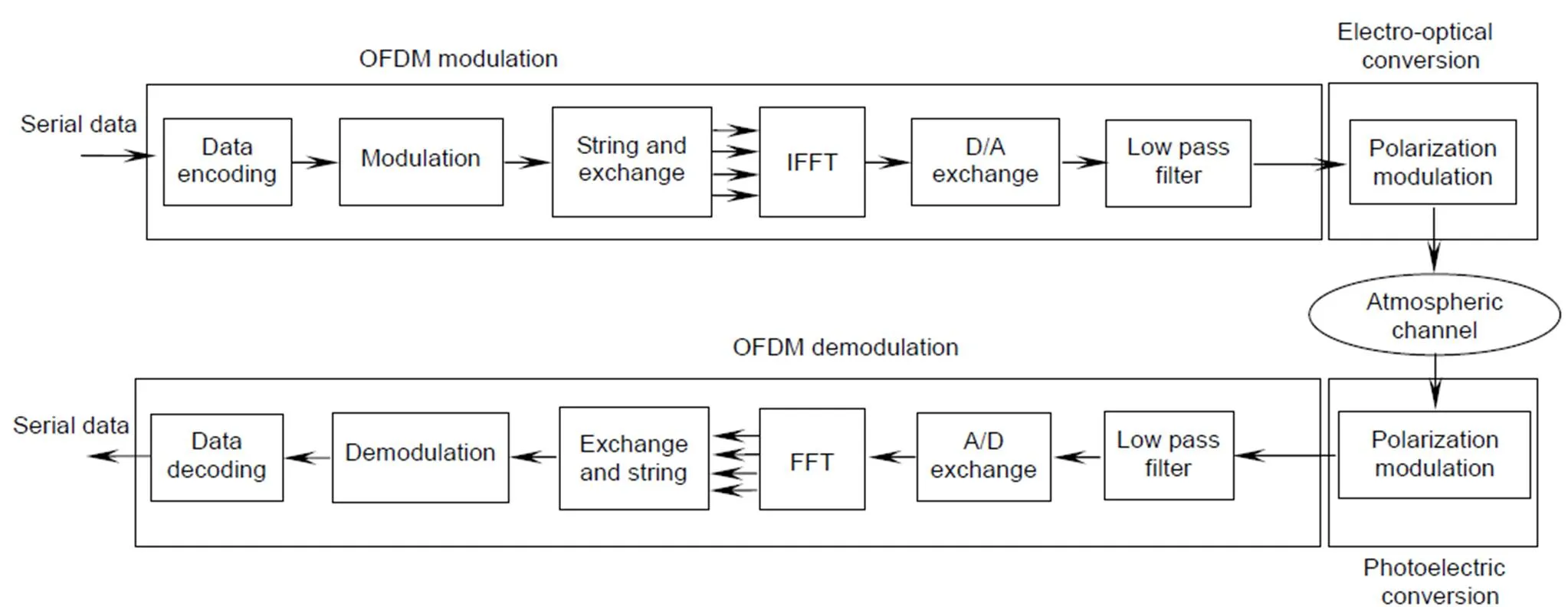
图6 FSO-OFDM系统基带模型图

图7 FSO-OFDM系统信号的调制与解调
5 激光大气传输实验与仿真
5.1 FSO通信系统的不同载波下的平均误码率特性实验
在本次仿真中,根据OFDM系统的基带模型,采用MATLAB编程实现FSO-OFDM系统,对多径干扰下的FSO通信系统进行仿真实验,其仿真结果如图8所示。信号源是由MATLAB的随机函数产生的一帧OFDM信号,采用16进制正交幅度调制(16QAM)作为调制解调方案,子载波数为64路,保护间隔分别为16。图8红色线为多径干扰环境下单载波FSO系统的误码率特性曲线,蓝色线为多径干扰环境下有OFDM调制的FSO系统误码率特性曲线。
对比单载波无线光通信系统与FSO-OFDM通信系统的平均误码率性能曲线图,可以看出,红色线所表示的单载波光通信系统,误码率整体高于蓝色线所表示的FSO-OFDM系统的误码率。当系统信噪比SNR=6 dB时,单载波FSO系统的误码率为0.0501,采用了OFDM的多载波FSO系统的误码率为0.0417。说明与传统的单载波系统相比,文章所设计的多载波无线光正交频分复用系统,能有效改善FSO通信系统的误码率特性。
5.2 FSO通信系统不同保护间隔下的误码率特性实验
基于FSO通信系统的特点及原理,在16-QAM的调制方式下,用MATLAB仿真验证不同保护间隔下的结果。在IFFT运算后加入信道噪声,此次试验加入了高斯白噪声(AWGN)作为实际信道的仿真模型。在有无循环前缀的情况,对OFDM系统的误码率性能进行仿真。设置保护间隔的时间为1=170e-9,循环前缀的时间为2=1=170e-9。
图9红色线为没有加循环前缀的FSO系统的误码率特性曲线,蓝色线为有循前缀的FSO系统误码率特性曲线,在高斯白噪声(AWGN)信道下,对结果进行对比分析。从图9可以看出,加入循环前缀的系统的误码率性能优于没有加循环前缀的通信系统。当信噪比SNR为12 dB时,OFDM符号中不加保护间隔(无前缀)时,无线通信系统的误码率BER为0.0014;OFDM符号中加入保护间隔时,系统的误码率BER为0.0013。

图8 不同载波数下的误码率特性曲线

图9 不同保护间隔下的误码率特性曲线
6 结 论
激光大气信道问题尤其是不同湍流强度下的光强度起伏效应等,会导致无线激光通信出现码间干扰大、链路不可靠等。针对目前制约大气激光通信应用的主要瓶颈问题¾湍流效应,文章在深入分析无线激光通信中存在两种主要的大气信道问题的基础上,对复杂湍流环境下的频率选择性衰落问题和多径效应问题形成机理开展了深入研究,在给出Kolmogorov谱模型的基础上,研究了平面波模型;利用修正的Rytov方法,建立了Log-normal湍流信道下的高斯光束空间光通信系统模型,推导得出了的系统光波强度的概率密度函数;设计了无线光通信系统的OFDM多载波调制方案,构建了FSO-OFDM系统基带模式模型,并基于该模型研究了其信号的调制与解调原理;进行了无线激光通信系统误码率特性仿真验证,结果表明,FSO-OFDM系统可支持更高的信息传输速率,改善了激光信号大气信道传输问题,具有良好的BER性能,这为突破光通信的瓶颈提供了技术方法。
[1] Ke X Z, Wang S. Evolution of the intensity of partially coherent airy beam in atmospheric turbulence[J]., 2017, 46(7): 0701001.
柯熙政, 王松. 部分相干Airy光束在大气湍流中的光强演化[J]. 光子学报, 2017, 46(7): 0701001.
[2] Lukin V P, Pokasov V V. Optical wave phase fluctuations[J]., 1981, 20(1):421–135.
[3] Kumar R S P, Khan M A J, Nitesh G. Performance analysis of a free space optics link with multiple transmitters/receivers[J]., 2012, 13(3): 254–258.
[4] Zhao L, Zhong T, Liu Z G,. An annular light source layout model for both lighting and communication reliability[J]., 2018, 45(7): 170503.
赵黎, 朱彤, 刘智港, 等. 一种兼顾照明与通信的环形光源布局模型[J]. 光电工程, 2018, 45(7): 170503.
[5] Su C X, Song P, Meng C,. The pulse broadening ranging method of wireless ultraviolet optical communication[J]., 2019, 33(2): 161–167.
苏彩霞, 宋鹏, 孟超, 等. 无线紫外光通信脉冲展宽测距方法[J]. 西安工程大学学报, 2019, 33(2): 161–167.
[6] Liao T H, Liu W, Gao Q. Turbulent effects of laser beams of different shapes in the atmosphere[J]., 2015(S1): 41–45.
廖天河, 刘伟, 高穹. 不同形状激光波束在大气中传输的湍流效应[J]. 红外与激光工程, 2015(S1):41–45.
[7] Švihlík J,Krbcova Z, Tran Q V,. Stochastic and analytic modeling of atmospheric turbulence in image processing[J].., 2018: 10752.
[8] Torrieri D J.[M]. 3rd ed. Cham: Springer, 2015.
[9] Wang Y, Wang D L, Ma J. On the performance of coherent OFDM systems in free-space optical communications[J]., 2015, 7(4): 7902410.
[10] Shi M, Zhang M J, Chi N. Two input one output visible light communication system based on pulse amplitude modulation[J]., 2019, 46(5): 180306.
石蒙, 张梦洁, 迟楠. 基于脉冲幅度调制的两发一收可见光通信系统[J]. 光电工程, 2019, 46(5): 180306.
[11] Wu P F, Jia L Y. Experimental analysis of atmospheric coherence length measurement in Xi'an area[J]., 2019, 57(9): 090101.
吴鹏飞, 贾璐瑶. 西安地区大气相干长度的实验测量及分析[J]. 激光与光电子学进展, 2019, 57(9): 090101.
[12] Singhal P, Gupta P, Rana P. Basic concept of free space optics communication (FSO): an overview[C]//(), Melmaruvathur, 2015: 0439–0442.
[13] Khare S, Sahayam N. Analysis of free space optical communication system for different atmospheric conditions & modulation techniques[J].h (), 2012, 2(6): 4149–4152.
Research on the key technology of turbulence suppression for atmospheric optical laser communication based on OFDM
Guo Qian*, Song Peng, Zhang Zhouqiang, Zhou Awei, Qu Pingge
School of Mechanical and Electrical Engineering, Xi¢an Polytechnic University, Xi'an, Shaanxi 710048, China

Baseband model of the FSO-OFDM system
Overview:In order to support higher information transmission rate, improve the system error characteristics, solve the problems of frequency selective fading and multipath effect of the wireless optical communication system in complex turbulent environment, improve laser atmospheric channel signal transmission problems, based on orthogonal frequency division multiplexing technology, the FSO-OFDM system was built, the multicarrier modulation, modulation and demodulation, etc used this system were studied. Firstly, the turbulence effect, which is a bottleneck problem restricting the application of atmospheric laser communication, was discussed in detail. Then, on the basis of Kolmogorov spectrum model, the plane wave model was studied. By using the modified Rytov method, the spatial optical communication system model of Gaussian beam under log-normal turbulence channel was established, and the probability density function of the system light wave intensity was derived. Then, the OFDM multi-carrier modulation scheme of the wireless optical communication system was designed, the baseband mode model of the FSO-OFDM system was constructed, and the modulation and demodulation of the signal were studied using this model. When the signal of the binary signal source was sent out, it was encoded and modulated to the series-and-conversion module for series-and-conversion, followed by IFFT exchange. After digital-to-analog conversion and filtering, electro-optical conversion was carried out, which becomes the signal() modulated by OFDM. After passing through the atmospheric channel, the signal was sent to the receiving module of the FSO-OFDM system, which is photoelectric converted, low-pass filtering, and then converted by mode/number to restore the orthogonality of the subcarrier. After FFT and string/combination conversion, the signal was restored to the signal before OFDM modulation. After demodulation and decoding, the original input signal was restored. Finally, MATLAB programming was adopted to realize the FSO-OFDM system. Simulation experiments were carried out on the FSO communication system under multi-path interference. Under the same bandwidth condition, the average bit error rate performance of the single-carrier wireless optical communication system and the FSO-OFDM communication system were simulated, respectively. Compared with the traditional single-carrier system, the OFDM system improves the atmospheric channel transmission of laser signal and the information transmission rate.FSO-OFDM system has a strong ability to resist multi-path interference and spectrum selective fading, as well as a good BER performance. It provides a technical method to break through the bottleneck of optical communication and has a very wide application prospect and value.
Citation: Guo Q, Song P, Zhang Z Q,Research on the key technology of turbulence suppression for atmospheric optical laser communication based on OFDM[J]., 2020, 47(3): 190619
Research on the key technology of turbulence suppression for atmospheric optical laser communication based on OFDM
Guo Qian*, Song Peng, Zhang Zhouqiang, Zhou Awei, Qu Pingge
School of Mechanical and Electrical Engineering, Xi¢an Polytechnic University, Xi'an, Shaanxi 710048, China
Based on the analysis of the two main problems of atmospheric channel in free space optics (FSO), aiming at the problem of laser atmospheric channel especially the problems of frequency selective fading and multipath effect in complex turbulent environment, the suppression method is proposed based on OFDM turbulence effect, the FSO-OFDM system is built, the baseband model of this system and the signal of multi-carrier modulation and demodulation method are studied. First of all, this article systematically analyzes the mechanism of turbulence effect of atmospheric channel, and discusses the model of plane wave laser communication system under the influence of atmospheric turbulence, the space optical communication system model of Gaussian beam of a logarithmic normal turbulent channel is established under the influence of atmospheric turbulence, the probability density function of light intensity is deduced, the methods for analyzing the effects of various atmospheric turbulence effects on system performance using the signal-to-noise ratio probability density function; the OFDM multi-carrier modulation scheme of FSO-OFDM system is designed, the baseband mode model of FSO-OFDM system is constructed, and the modulation and demodulation principle of its signal is studied using this model. Finally, FSO-OFDM system is realized by using MATLAB, and the FSO communication system under the multipath interference is simulated, experiments on bit error rate characteristics under different guard intervals are performed. It is confirmed that the FSO-OFDM system has a strong ability to resist multipath interference and frequency selective fading, as well as good bit error rate (BER) performance. It can effectively solve the problem of intersymbol interference and the reliable link, and has a very broad application prospect and using value.
free space optics; turbulence effect; orthogonal frequency division multiplexing; multipath fading; bit error rate
TN929.1
A
10.12086/oee.2020.190619
: Guo Q, Song P, Zhang Z Q,. Research on the key technology of turbulence suppression for atmospheric optical laser communication based on OFDM[J]., 2020,47(3): 190619
2019-10-15;
2019-12-24
国家自然科学基金资助项目(61701384);陕西省教育厅科研计划基金资助项目(18JK0341);西安市科技局科技创新基金资助项目(201805030YD8CG14(12))
郭倩(1984-),女,硕士,讲师,主要从事信息与信号处理的研究。E-mail:guoqianyun@126.com
郭倩,宋鹏,张周强,等. 基于OFDM的大气激光通信湍流抑制关键技术研究[J]. 光电工程,2020,47(3): 190619
Supported by National Natural Science Foundation of China (61701384), Scientific Research Program Fund of Education Department of Shaanxi Province (18JK0341), and Xi¢an Science and Technology Bureau Science and Technology Innovation Fund (201805030YD8CG14 (12))
* E-mail: guoqianyun@126.com

